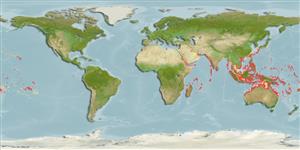Common names from other countries
Classification / Names / Names
Namen | Synonyme | Catalog of Fishes (gen., sp.) | ITIS | CoL | WoRMS
Environment: milieu / climate zone / depth range / distribution range
Ökologie
Riff-verbunden; tiefenbereich 0 - 40 m (Ref. 848). Tropical; 36°N - 34°S, 32°E - 135°W (Ref. 848)
Indo-Pacific: widespread in East Africa, including Red Sea to Polynesia, north to Japan and south to Solitary Islands, Australia.
Length at first maturity / Size / Gewicht / Alter
Maturity: Lm ? range ? - ? cm
Formation: encrusting to massive, rarely over 1 m across. Corallites: cerioid or subplocoid, circular, with thick walls. Septa have long pointed teeth. Thick fleshy tissue over the skeleton present, usually forming concentric folds. Color: uniform or mottled dull brown, gray or green, but can also be brightly colored (Ref. 848).
Occurs in most reef environments (Ref. 848).
Life cycle and mating behavior
Geschlechtsreife | Fortpflanzung | Ablaichen | Eier | Fecundity | Larven
Hermaphroditic (Refs. 113708, 113712). Mature gametes are shed into the coelenteron and spawned through the mouth. Life cycle: The zygote develops into a planktonic planula larva. Metamorphosis begins with early morphogenesis of tentacles, septa and pharynx before larval settlement on the aboral end (Ref. 833).
Veron, J.E.N. and G. Hodgson. 1989. (Ref. 8817)
IUCN Rote Liste Status (Ref. 130435)
CITES Status (Ref. 108899)
Not Evaluated
Nutzung durch Menschen
| FishSource |
Tools
Mehr Information
Alter/GrößeWachstumLänge-GewichtLänge-LängeMorphologieLarvenDichte
Internet Quellen
Estimates based on models
Preferred temperature
(Ref.
115969): 24.6 - 29, mean 27.9 (based on 1012 cells).
Preiskategorie
Unknown.
